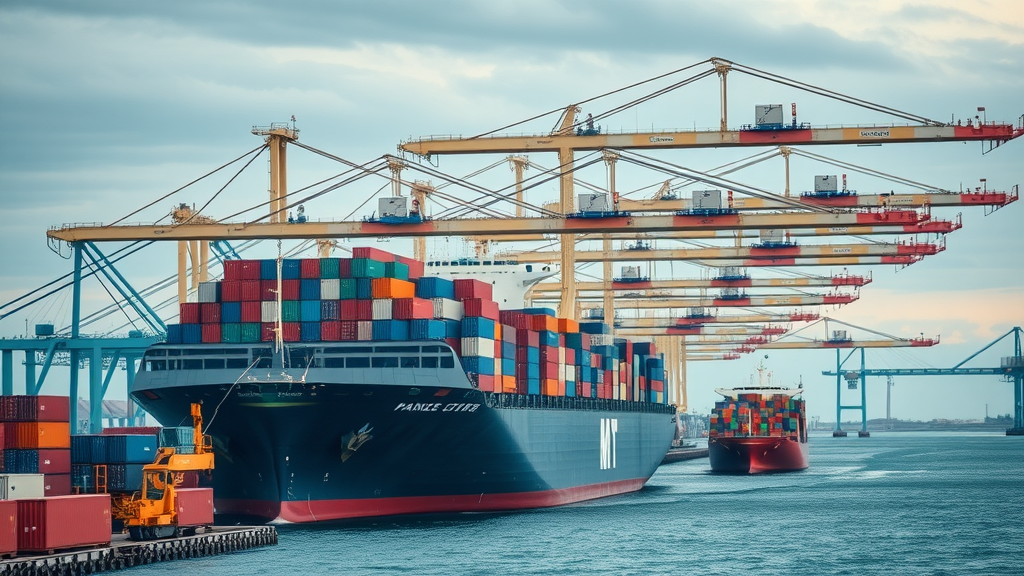Did you know? A single announcement of new tariffs can throw global supply chains into chaos overnight, with ripple effects pushing up consumer prices and production costs across multiple industries. In a business environment where geopolitical tensions and trade policies can shift at light speed, understanding the delicate relationship between tariff and supply chains is not just essential—it's critical for survival.
In this editorial, we take a bold look at how tariffs and supply chain disruptions can instantly redefine your business's prospects, profitability, and planning. With firsthand stories, powerful statistics, and genuine expert advice, you’ll learn how to anticipate, respond, and even thrive amid today’s ever-shifting global trade landscape.
A Startling Truth: How Tariff and Supply Chains Influence Business Overnight
The world of tariff and supply chains is one where yesterday’s assumptions can evaporate with a single tweet or policy change. Trade wars—like the intense U.S.-China conflict—have repeatedly proven that business as usual simply doesn’t exist anymore. The impact is both immediate and wide-reaching: when new tariffs are imposed, businesses face overnight increases in raw material costs, surprise supply chain delays , and complex sourcing challenges.
Many organizations discover too late that ignoring the signals—such as shifting trade agreements, increasing imported goods fees, or changing regulations in North America or Asia—can expose them to financial risks that cascade through their entire operation. Whether you’re importing automotive parts or exporting high-tech electronics, the mechanisms that move your products from A to B are constantly at the mercy of political decisions that upend established patterns. In this climate, bold, data-driven action has become the only way to insulate your business from overnight upheaval.
Why Ignoring Tariff and Supply Chains Could Cost You — The Unseen Risks for Today’s Businesses
Many leaders still view tariffs and supply chains as distant, background issues rather than immediate business priorities. However, ignoring these complexities could cost you dearly: rapidly rising production costs , surprise supplier exits, and the need to navigate complex trade policy changes can all add up to steep losses. The domino effect doesn’t just stay on the balance sheet—it hits your workforce, your brand reputation, and even your ability to serve loyal customers.
As recent trade war episodes demonstrate, risks are no longer hidden in the margins; they’ve moved front and center. Stories abound of businesses blindsided by “ tariff shock ” because their global supply chain strategies were built for a calmer world. The best leaders are those who anticipate these shocks, prioritize adaptable strategies, and stay keenly aware of the ever-changing regulatory environment. Ultimately, it’s your ability to react to these shifts that will separate your business from the rest.
- Unexpected ripple effects of tariff and supply chains on your organization
- Key statistics and stories shaping global supply chain reactions
- Essential strategies to safeguard your business
- Insights from leading business voices
"In a world more interconnected than ever, tariffs and supply chains don’t just impact trade—they define business survival."
Understanding the Relationship Between Tariff and Supply Chains
To grasp why tariff and supply chains so powerfully affect your bottom line, it’s helpful to look beneath the surface of modern global trade . Tariffs are essentially taxes placed on imported goods , and when these increase—even by a point or two—they send shockwaves through every link in your supply chain . Imagine sourcing a critical component from overseas, only to discover that new tariffs have doubled its cost overnight. Instantly, you’re confronted with a fresh set of challenges: renegotiating contracts, adjusting delivery timelines, and grappling with the competitive pressures unleashed by higher prices.
Supply chains today are complex, interconnected webs spanning continents and time zones. A tariff introduced on Chinese imports , for instance, does not only impact the direct buyer; it affects third- and fourth-tier suppliers, logistics companies, and ultimately the final consumers. Being prepared and having a deep understanding of how tariffs influence global supply chains can mean the difference between disruption and opportunity. Businesses must now build flexibility and transparency into their chain management and have a clear grasp of where vulnerabilities may arise.

How Tariff and Supply Chains Shape the Global Supply Economy
At their core, tariff and supply chains mechanisms help shape not only individual businesses, but entire regional and global economies. The introduction of new tariffs often leads to shifts in the flow of goods around the world. Sometimes, supply chain managers must reroute shipments, seek out alternative suppliers, or face the difficult reality of increased costs for raw materials and logistics. The ripple effects of a government’s trade policy can thus significantly impact everything from consumer pricing to employment figures—and even international economic stability.
With rising attention on global supply chains —especially in light of high-profile trade wars —industry leaders now acknowledge that supply chain management must go far beyond simple cost-cutting. Agile businesses evaluate risks as soon as a new tariff is announced, often diversifying their supplier base and seeking innovations that allow them to absorb shock when global trade tensions erupt.
- Costs of raw materials
- Global supply chain delays
- Supplier diversification
- Pricing and competitiveness
Global Supply Chain Disruptions: The Domino Effect of Tariff and Supply Chains
When high tariffs are introduced, global supply chain disruptions are not far behind. The results manifest in many ways: shipping delays, reallocated production, an urgent need for supplier diversification, and—frequently—a rise in consumer prices . These effects interact and cascade, creating an unpredictable “domino effect” through every level of an organization’s supply chain management.
Regions with different average tariffs confront unique challenges. Take North America , where moderate tariffs (around 4.3%) can still result in long delays and mounting costs. In Europe , even slightly lower tariffs can prompt supplier shifts and price increases, while Asia-Pacific faces the turbulence of trade wars and sudden rerouting of goods. Understanding these regional differences—and how your business fits into the broader picture—is essential for success in today’s global economy.
| Region | Average Tariff (%) | Common Supply Chain Impact |
|---|---|---|
| North America | 4.3 | Delays, increased costs |
| Europe | 3.4 | Supplier shifts, price hikes |
| Asia-Pacific | 5.8 | Trade wars, rerouting |

Trade War Fallout: Case Studies in Tariff and Supply Chains
Consider the fallout from the recent U.S.-China trade war . When the Trump administration imposed steep tariffs on Chinese imports , the move reverberated through every layer of the global supply chain . Businesses were forced to rethink established supplier arrangements and adapt to an unprecedented pace of change. Some responded by investing in domestic sourcing or shifting operations to Southeast Asia; others struggled to survive as new production costs and tariffs battered their bottom lines. According to the World Bank, the overall cost to the global economy exceeded $1.7 trillion, illustrating just how costly tariff and supply chains disruption can be.
Other case studies highlight different risks and opportunities. For instance, European firms reacted to U.S. tariffs by deepening intra-Europe supplier networks and lobbying for new trade agreements —a move that underscored both the vulnerability and resilience of modern supply chains. Large manufacturers in North America, facing repeated tariff shocks , accelerated the adoption of advanced analytics to map out exposure and reinforce alternative supply options. The lesson? Strategic agility and cross-border thinking now define the winners and survivors in a world of frequent trade wars.
"The US-China trade war alone cost the world economy an estimated $1.7 trillion — and businesses are still adapting."
Practical Strategies for Business Leaders Amid Tariff and Supply Chains Volatility
Navigating the volatility of tariff and supply chains requires both vigilance and innovation from modern business leaders . Successful companies are those that anticipate disruption, plan proactively, and develop practical strategies to maintain supply chain resilience even as global trade tensions escalate. The following steps, widely adopted by leaders across manufacturing, technology, and retail, are designed to help companies stay agile.
For example, investing in advanced supply chain risk analytics enables organizations to spot vulnerabilities before they become crises. Meanwhile, negotiating flexible contracts with suppliers helps organizations adjust quickly to new tariffs or geopolitical tensions. By keeping a close eye on evolving trade policy developments worldwide, business leaders can pivot strategically to secure critical materials and maintain competitive pricing.
- Diversify supplier networks across regions
- Increase stockpiling of critical components
- Invest in supply chain risk analytics
- Negotiate flexible contracts with suppliers
- Monitor global trade policy changes actively

Steps Businesses in North America Are Taking to Alleviate Tariff and Supply Chain Pressure
Companies across North America have responded to escalating high tariffs and shifting global supply chain realities with innovative solutions. Multinational manufacturers have accelerated their relocation of certain production facilities closer to end markets, thereby mitigating the impact of trade shocks and reducing long shipping lead times. By forging stronger relationships with regional suppliers, businesses create greater stability and cushion themselves from the immediate effects of future tariff changes.
Additionally, North American retailers—especially those reliant on imported electronics or apparel—are investing more in risk analysis tools and digital chain management. Proactive actions like signing flexible, short-term supplier contracts and diversifying sourcing lifelines have become the new gold standards for resilience. The lesson is clear: in a world of trade wars and tariff shocks, flexibility and data-driven insight are the key assets for every business leader.
Impact of High Tariffs on Supply Chain Efficiency: Proof from Real Data
The real-world impact of high tariffs on supply chain efficiency is vivid across multiple industries. Studies reveal that sectors like automotive, electronics, and apparel each face disruptions uniquely tethered to rising tariffs and geopolitical uncertainty. For automotive manufacturers, shipment delays have become the norm, as critical parts sourced globally either become too costly or simply unavailable. Electronics firms see costs spike as trade conflicts disrupt intricate international assembly networks, forcing both price hikes and abrupt vendor changes.
Meanwhile, apparel brands—long dependent on efficient global supply chains —struggle with the need to relocate suppliers and manage unexpected swings in production costs . Across all these sectors, the fundamental takeaway is clear: when tariffs rise, everyone from shop floor workers to end consumers feels the effects in terms of efficiency, cost, and supply chain stability.
| Industry | Impacted by Tariffs (%) | Most Common Disruption |
|---|---|---|
| Automotive | 85% | Delayed shipments |
| Electronics | 92% | Increased costs |
| Apparel | 76% | Supplier relocation |

How Global Trade Wars and High Tariffs Impact Supply Chain Decisions
The escalation of trade wars and the imposition of high tariffs have fundamentally altered how businesses manage their supply chain decisions. Now, every procurement, logistics, and sourcing strategy must account for the possibility of sudden price hikes or blocked trade routes. Supply chain managers sift through real-time data and predictive analytics, mapping out “what if” scenarios with a zeal that was once reserved for financial crises rather than routine operations.
One consistent lesson is that adaptability and rapid response are crucial. Companies willing to move fast—establishing alternative suppliers, renegotiating freight contracts, or investing in local manufacturing—have fared better than those clinging to familiar practices. Trade negotiations, shifts in global policy, and abrupt tariff adjustments are no longer exceptions; they are the rule. Leaders embracing supply chain agility have proven themselves best positioned to survive the turbulence.
Lessons Learned from Ongoing Global Trade Tensions
The past decade has delivered sobering lessons about the necessity of agility in global supply chain management. Businesses learned that risk can no longer be measured only in cost or efficiency terms—but must include resilience and speed of adaptation. As trade wars erupted and tariffs on Chinese imports soared, adaptive companies reaped the rewards, swiftly rerouting sourcing and leveraging digital platforms for greater transparency.
Today’s business managers know that building resilient supply chains means planning not just for the most probable scenario, but also for low-probability, high-impact trade shocks. Trustworthy and collaborative supplier relationships, high levels of digital visibility, and open communication lines with cross-border partners all lie at the heart of post-pandemic supply chain success. Amid ongoing trade negotiations, those who position themselves ahead of the curve become leaders; others are left scrambling to catch up.
"Business leaders who adapt fast to tariff and supply chains turbulence are defining the new normal for global supply."
People Also Ask: How Do Tariffs Affect the Supply Chain?
When tariffs are imposed, businesses in global supply chains must pay higher import fees. This increases their costs, leads to higher prices for consumers, and often disrupts established supply chain processes as companies seek alternative suppliers or markets.

People Also Ask: How Tariffs Shock the Supply Chain?
Tariff shocks can create sudden and unexpected disruptions in supply chains by causing delays, rerouting shipments, and forcing quick changes in sourcing strategies.
People Also Ask: What Are the 4 Types of Tariffs?
The four main types are: Ad Valorem tariffs, Specific tariffs, Compound tariffs, and Tariff-rate quotas—each affecting supply chains differently in terms of cost and compliance.
People Also Ask: Do Tariffs Decrease Supply or Demand?
Generally, tariffs tend to decrease demand by raising prices for consumers; they also reduce supply by making imports less attractive or more expensive.

Key Insights for Business Leaders: Adapting to a Tariff and Supply Chains World
Leading through the current era of tariff and supply chains disruption demands more than robust planning; it calls for culture change. Today’s top business leaders place adaptability and global awareness at the heart of their strategies. They invest in staff training, elevate digital competencies, and foster open communications with every key supplier.
These leaders understand that preparing for tariff shock is not a one-time fix but an ongoing commitment. They elevate supply chain management to the executive agenda, ensuring every department—from procurement to sales to logistics—works in harmony toward risk-aware and forward-thinking decision-making. In the fast-moving world of global trade, strong leadership and strategic vision are the real differentiators between thriving and merely surviving.
"No business can escape the reach of tariffs and supply chains—those who plan now will thrive, while others will scramble to catch up."
Frequently Asked Questions About Tariff and Supply Chains
-
How should small businesses respond to sudden tariff changes?
Small businesses should actively monitor global trade policies, build diverse supplier relationships, and remain nimble—ready to pivot quickly in response to new tariffs. Investing in digital supply chain management can help SMEs gain real-time visibility and increase resilience. -
Are some global supply chains more resilient to tariffs than others?
Yes, businesses employing multi-region supplier networks and leveraging advanced analytics tend to fare better during tariff shocks. Industries with near-shoring or balanced international production are positioned to absorb impacts more effectively. -
Is reshoring a viable strategy given modern supply chain realities?
For some industries, reshoring (bringing production back home) can decrease exposure to tariff uncertainties and improve responsiveness. However, it requires careful evaluation of cost, infrastructure, and workforce availability. Many companies are blending local and offshore approaches for greater stability.
Take Your Stand on Tariff and Supply Chains: Share Your Expertise With Global Trade Notes
Got Something to Say About Global Trade? RP Design Web Services can put your insights on Global Trade Notes in front of the right audience. Call 203-271-7991 today and get your word out.
Conclusion
Take proactive steps: diversify suppliers, invest in risk analytics, and stay alert to global trade changes. Resilient, informed leaders will transform tariff and supply chain threats into opportunities—starting today.
Understanding the intricate relationship between tariffs and supply chains is crucial for businesses aiming to navigate the complexities of global trade. The article “Implications of Tariffs on the Supply Chain” by NetSuite provides a comprehensive overview of how tariffs can disrupt supply chains, leading to increased costs and necessitating strategic adjustments. Additionally, “The Escalating Impact of US Tariffs on Supply Chains” by TrueCommerce delves into the cascading effects of tariffs across various industries, highlighting the importance of proactive supply chain management. For a deeper understanding of these dynamics, these resources offer valuable insights into mitigating risks and enhancing supply chain resilience.
 Add Row
Add Row  Add
Add 




Write A Comment